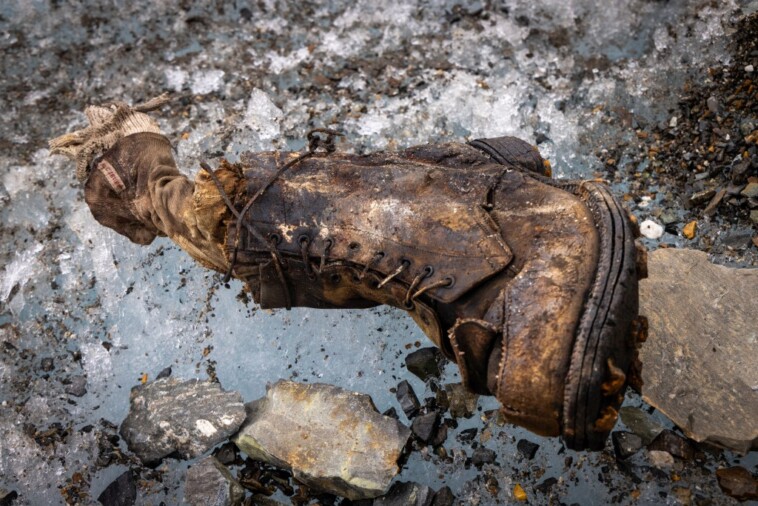The partial remains of Andrew “Sandy” Irvine — who disappeared a century ago while trying to become one of the first people to climb Mount Everest — are believed to have been found on the mountain.
A team of National Geographic climbers and filmmakers stumbled upon an old leather boot with steel hobnails on the treacherous north face of the world’s highest mountain last month, according to the outlet.
Inside the shoe, the team discovered the remains of a foot encased in a sock embroidered with the name “A.C. IRVINE,” presumably for Andrew Comyn “Sandy” Irvine.
“I lifted up the sock, and there’s a red label that has A.C. IRVINE stitched into it,” team director Jimmy Chin said of the stunning find.
The team immediately recognized the importance of what they were looking at, he added.
“We were all literally running in circles dropping F-bombs,” Chin recalled.
Irvine was only 22 when he and George Mallory vanished while attempting to become the first people to summit Everest on June 8, 1924.
Mallory and Irvine were last seen 800 vertical feet from Everest’s peak.
The question of whether the pair reached the summit before they disappeared has haunted the climbing community for a century, National Geographic noted.
If Mallory and Irvine did make it to the top of Everest — and were lost on their descent — they would have achieved the amazing feat 29 years before Sir Edmund Hillary and Tenzing Norgay conquered the summit.
Mallory’s remains were found in 1999.
He had evidence of a rope still tied around his waist, which suggested that he and Irvine may have been roped together when one or both of them fell, National Geographic explained.
The team that discovered Mallory’s remains also found some circumstantial clues that suggested he and Irvine did reach the summit before they died.
The researchers discovered several personal effects and letters with Mallory’s remains but did not find a photograph of his wife, Ruth.
According to Mallory’s daughter, the climber planned to leave the photo on the summit of Everest.
Mallory was also found with his dark snow goggles in his pocket, which suggested that the deadly fall could have happened in the evening, while he and Irvine were making their way back down the mountain.
Nothing about the Irvine find added to or subtracted from the theory.
But last month’s discovery was “the first real evidence of where Sandy ended up,” Chin said.
Several days before Chin’s team found Irvine’s boot, they also found a 1933 oxygen cylinder near the Central Rongbuk Glacier.
The cylinder likely came from the fourth British Everest attempt nine years after Mallory and Irvine vanished, Chin said. Those climbers notably found an ice ax belonging to Irvine on the mountain’s northeast ridge.
The discovery of the cylinder prompted Chin and his team to comb the area for evidence of Irvine’s remains, leading them to eventually stumble upon the boot.
“If Sandy had fallen down the north face, his remains or his body could be somewhere near here,” Chin said.
If the oxygen canister had fallen off the mountain, “it probably fell down quite a bit farther than a body — more like a missile,” he added.
Chin declined to elaborate on where exactly the boot was found, as he wanted to discourage potential trophy hunters.
But he was confident that more artifacts — and potentially even Irvine’s Kodak Vest Pocket Camera — could be close by.
One of Chin’s first calls about the find was to Irvine’s great-niece Julie Summers, 64, who wrote a 2001 biography of the lost climber.
“When someone disappears and there’s no evidence of what happened to them, it can be really challenging for families,” Chin said. “And just having some definitive information of where Sandy might’ve ended up is certainly [helpful] and also a big clue for the climbing community as to what happened.”
Summers said she was grateful that some part of her long-lost great-uncle had been found.
“It’s an object that belonged to him and has a bit of him in it,” she said of the worn boot. “It tells the whole story about what probably happened.”
In her book, Summers wrote that Irvine’s leather boots were purchased for 5 pounds, 3 shillings from the bootmaker James J. Carter in London.
The rest of Irvine’s remains were likely swept down the mountain by avalanches and crushed by a moving glacier, Summers guessed.
“I’m regarding it as something close to closure,” she said of the boot’s discovery.
Members of Irvine’s family have volunteered DNA samples in order to confirm that the foot in the sock is indeed his.
Formal identification is still pending, National Geographic noted.
“But I mean, dude … there’s a label on it,” Chin said.










